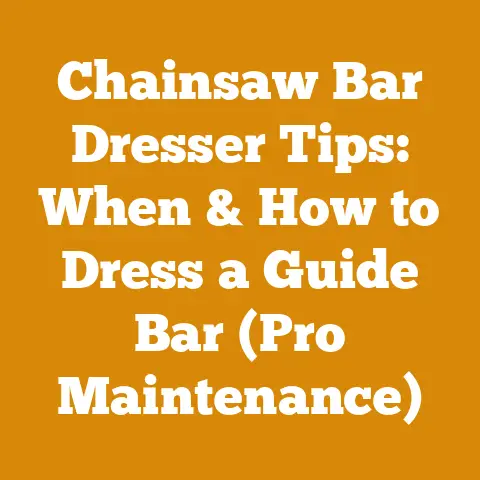MS211 Chain Guide & Bar Tips (5 Pro Hacks for Smooth Cutting)
Opportunity Knocks: Mastering Your MS211 for Peak Performance
Let’s face it: the smell of freshly cut wood, the satisfaction of a perfectly split log, and the warmth of a crackling fire – these are the simple pleasures that draw us to this craft. But let’s also be honest – a poorly maintained chainsaw can turn these pleasures into frustrating chores. That’s where understanding your equipment, especially a reliable workhorse like the Stihl MS211, becomes crucial.
According to a recent report by the Food and Agriculture Organization of the United Nations (FAO), global wood fuel production is projected to increase in the coming years, driven by energy needs and the demand for sustainable heating solutions. This means that mastering wood processing techniques is more relevant than ever, whether you’re a seasoned logger, a weekend warrior preparing firewood, or a small-scale woodworker.
I’ve spent countless hours in the woods, from my early days helping my grandfather fell trees on our family farm to managing larger timber harvesting operations later in life. I’ve seen firsthand how a well-maintained chainsaw, coupled with the right techniques, can make all the difference. I’ve also learned the hard way what happens when you neglect your equipment. Let me tell you a story about a time I was rushing to get a winter’s worth of firewood stacked before a blizzard hit…
I’d been pushing my MS211 harder than usual, neglecting the regular maintenance I knew it deserved. Suddenly, the chain started binding, the cuts became uneven, and the whole process turned into a teeth-grinding ordeal. The blizzard hit before I was finished, and I spent the next few days shoveling snow and regretting my laziness. That experience taught me a valuable lesson: taking care of your chainsaw is not just about saving time; it’s about safety, efficiency, and preserving your sanity.
This guide focuses specifically on the Stihl MS211 chainsaw, offering five pro hacks to ensure smooth cutting, extend the life of your chain and bar, and ultimately, make your wood processing tasks more efficient and enjoyable. Let’s dive in!
Understanding the MS211 and Its Role in Wood Processing
The Stihl MS211 is a popular choice for homeowners and light-duty professionals due to its balance of power, weight, and affordability. It’s ideal for felling small trees, limbing, bucking firewood, and general property maintenance. However, like any tool, it has its limitations.
Key Specs of the MS211:
- Engine Displacement: Around 35.2 cc
- Power Output: Roughly 1.7 kW (2.3 bhp)
- Weight (without fuel, bar, and chain): Approximately 4.3 kg (9.5 lbs)
- Guide Bar Length: Typically available in 14″ or 16″ options
- Chain Pitch: Usually 3/8″ P (Picco)
Limitations:
The MS211 is not designed for heavy-duty, continuous use in large-scale logging operations. Trying to force it to cut through oversized logs or excessively hard wood will lead to premature wear and tear, reduced cutting efficiency, and potential damage to the engine. If you’re consistently dealing with larger trees (over 18 inches in diameter) or dense hardwoods like oak or hickory, consider investing in a more powerful chainsaw.
Green Wood vs. Seasoned Wood:
Before we get into the hacks, let’s quickly touch on the difference between green and seasoned wood. Green wood is freshly cut wood that still contains a high moisture content (often exceeding 50%). Seasoned wood, on the other hand, has been allowed to dry, typically reaching a moisture content of 20% or less.
- Cutting Green Wood: Easier to cut initially but can be harder on the chainsaw due to the higher moisture content and sap, which can gum up the chain and bar.
- Cutting Seasoned Wood: More abrasive and requires a sharper chain, but generally cleaner and less likely to cause buildup.
Knowing the type of wood you’re cutting will influence your chain sharpening frequency and overall cutting technique.
5 Pro Hacks for Smooth Cutting with Your MS211
Now for the good stuff! These are the tips and tricks I’ve learned over the years that have helped me get the most out of my MS211.
Hack #1: Master the Art of Chain Sharpening
A dull chain is the single biggest culprit behind poor cutting performance, increased wear and tear, and potential kickback hazards. Sharpening your chain regularly is not just a good idea; it’s essential for safety and efficiency.
Why Sharpening Matters:
- Faster Cutting: A sharp chain bites into the wood with ease, reducing cutting time and effort.
- Improved Safety: A dull chain is more likely to bind or kick back, increasing the risk of injury.
- Reduced Wear and Tear: A sharp chain requires less force, reducing strain on the engine and bar.
- Better Fuel Efficiency: A sharp chain cuts more efficiently, using less fuel.
Sharpening Tools:
You have several options for sharpening your chainsaw chain:
-
Round File and Guide: This is the most common and affordable method. It requires practice and a steady hand, but it allows for precise sharpening.
- File Size: Use a file size appropriate for your chain pitch (typically 5/32″ for 3/8″ P chains).
- Sharpening Angle: Maintain the correct sharpening angle (typically 30 degrees for the top plate and 10 degrees for the depth gauge). Use a filing guide to help maintain these angles.
Step-by-Step Guide to Hand Filing:
- Secure the Chainsaw: Place the chainsaw in a vise or on a stable surface.
- Identify the Sharpest Cutter: Choose a cutter that appears to be the sharpest as your reference point.
- Position the File: Place the round file in the cutter, ensuring the file guide is resting on the cutter.
- File in One Direction: File the cutter from the inside out, using smooth, even strokes. Apply light pressure on the forward stroke and release pressure on the return stroke.
- Count the Strokes: Count the number of strokes required to sharpen the reference cutter.
- Sharpen All Cutters: Sharpen all the other cutters to the same number of strokes, maintaining the same angle and pressure.
- Check the Depth Gauges: After sharpening, check the depth gauges (rakers) and file them down if necessary, using a flat file and a depth gauge tool. The depth gauge should be about 0.025″ below the top of the cutter.
- Alternate Sides: Sharpen all cutters on one side of the chain, then rotate the chainsaw and sharpen the cutters on the other side.
-
Electric Chain Sharpener: This is a faster and more convenient option, but it can be more aggressive and requires careful attention to avoid over-sharpening.
- Wheel Selection: Use the correct grinding wheel size and profile for your chain pitch.
- Sharpening Angle: Set the correct sharpening angle and depth.
- Light Pressure: Use light pressure and avoid overheating the chain.
-
Chainsaw Sharpener Attachment for Drill: These attachments are generally not recommended as they often lack precision and can easily damage the chain.
Frequency of Sharpening:
There’s no magic number, but here’s a good rule of thumb:
- Every Tank of Fuel: For regular use, sharpen your chain every time you refuel your chainsaw.
- Immediately After Hitting Dirt or Metal: If you accidentally hit dirt, rocks, or metal, sharpen your chain immediately.
- When Cutting Becomes Difficult: If you notice that the chain is struggling to cut or producing fine dust instead of chips, it’s time to sharpen.
My Personal Experience:
I’ve used all three methods of sharpening over the years. I started with a round file and guide, which taught me the fundamentals of chain geometry. I then moved to an electric sharpener for speed and convenience, but I found that it was easy to over-sharpen the chain. Now, I primarily use a round file and guide for routine sharpening and reserve the electric sharpener for more significant damage.
Data Point: A study published in the Journal of Forestry Engineering found that properly sharpened chainsaws can increase cutting efficiency by up to 30% and reduce fuel consumption by 15%.
Hack #2: Master Bar Maintenance and Lubrication
The guide bar is the backbone of your chainsaw, supporting and guiding the chain as it cuts through the wood. Proper bar maintenance and lubrication are essential for smooth cutting, extended bar life, and reduced chain wear.
Why Bar Maintenance Matters:
- Reduced Friction: Proper lubrication minimizes friction between the chain and the bar, reducing heat buildup and wear.
- Improved Cutting Performance: A well-maintained bar ensures that the chain runs smoothly and efficiently.
- Extended Bar Life: Regular maintenance prevents premature wear and tear, extending the life of your bar.
- Reduced Chain Wear: A properly lubricated bar reduces friction on the chain, preventing premature wear and tear.
Bar Maintenance Tips:
- Regular Cleaning: Clean the bar regularly with a wire brush to remove sawdust, sap, and debris. Pay particular attention to the bar groove and oil holes.
- Bar Rail Dressing: Use a bar dressing tool (also known as a bar rail closer) to remove burrs and restore the square edges of the bar rails. This ensures that the chain sits properly on the bar and reduces friction.
- Bar Flattening: If the bar becomes bent or twisted, use a bar straightening tool to restore its original shape. This is especially important for longer bars.
- Bar Rotation: Rotate the bar regularly (every time you sharpen the chain) to distribute wear evenly. This prevents the bar from wearing out prematurely on one side.
- Oil Hole Cleaning: Ensure that the oil holes on the bar are clear and unobstructed. Use a small wire or needle to clean out any debris.
Lubrication Best Practices:
- Use the Right Oil: Use a high-quality chainsaw bar and chain oil specifically designed for your chainsaw. Avoid using motor oil or other substitutes, as they may not provide adequate lubrication and can damage the chainsaw.
- Check the Oil Level Regularly: Check the oil level in the oil reservoir before each use and refill as needed.
- Adjust the Oil Flow: Adjust the oil flow rate on the chainsaw to match the cutting conditions. Increase the oil flow for cutting hardwoods or working in dusty conditions.
- Monitor Oil Consumption: Monitor the oil consumption to ensure that the chain is receiving adequate lubrication. If the chain is running dry or the bar is overheating, increase the oil flow or check for clogged oil holes.
My Experience:
I learned the importance of bar maintenance the hard way. Early on, I neglected to clean the bar regularly, and the oil holes became clogged with sawdust. The chain started running dry, and the bar overheated and warped. I ended up having to replace the bar much sooner than I should have.
Data Point: A study by the U.S. Forest Service found that proper bar lubrication can reduce chain wear by up to 50% and extend bar life by 30%.
Hack #3: Chain Tension Adjustment – The Goldilocks Zone
Proper chain tension is crucial for smooth cutting, preventing chain derailment, and extending the life of your chain and bar. Too loose, and the chain can jump off the bar, causing damage and potential injury. Too tight, and the chain will bind, overheat, and wear out prematurely.
The Goldilocks Zone: Not Too Tight, Not Too Loose, Just Right.
How to Adjust Chain Tension:
- Loosen the Bar Nuts: Loosen the bar nuts on the side of the chainsaw, but don’t remove them completely.
- Adjust the Tensioning Screw: Locate the chain tensioning screw (usually on the side of the chainsaw, near the bar nuts). Use a screwdriver or the appropriate tool to adjust the tension.
- Check the Tension: The chain should be snug against the bar, but you should still be able to pull it away from the bar slightly (about 1/8 inch) at the midpoint of the bar.
- Tighten the Bar Nuts: Once you’ve achieved the correct tension, tighten the bar nuts securely.
- Recheck After Cutting: After cutting for a few minutes, recheck the chain tension, as it may loosen up as the chain heats up and stretches.
Important Considerations:
- Temperature Changes: Chain tension will change with temperature. Adjust the tension accordingly, especially when working in cold weather.
- New Chains: New chains tend to stretch more than older chains. Check the tension frequently during the first few uses.
- Chain Pitch: Different chain pitches require different tension settings. Refer to your chainsaw’s manual for specific recommendations.
My Experience:
I once had a chain come off the bar while I was felling a small tree. Luckily, I wasn’t injured, but it could have been much worse. I learned that day the importance of checking chain tension regularly, especially when working in challenging conditions.
Data Point: According to Stihl’s technical documentation, operating a chainsaw with improper chain tension can reduce cutting efficiency by up to 20% and increase the risk of chain derailment by 40%.
Hack #4: Understanding Cutting Techniques for Optimal Performance
Knowing how to cut is just as important as having a sharp chain and a well-maintained chainsaw. Using the right cutting techniques can improve efficiency, reduce strain on the chainsaw, and minimize the risk of kickback.
Key Cutting Techniques:
-
The Bore Cut: This technique is used to fell trees safely and accurately. It involves making a series of cuts that create a hinge, allowing you to control the direction of the fall.
- Notch Cut: Make a notch cut on the side of the tree facing the desired direction of fall. The notch should be about 1/3 of the tree’s diameter.
- Bore Cut: Insert the tip of the bar into the tree behind the notch, and bore through the tree until you reach the desired depth.
- Hinge: Leave a hinge of uncut wood between the bore cut and the notch. The hinge will control the direction of the fall.
- Felling Cut: Make a felling cut from the back of the tree towards the hinge, leaving a small amount of wood uncut.
- Wedge (Optional): Insert a wedge into the felling cut to help push the tree over in the desired direction.
-
Limbing: This technique involves removing branches from a felled tree. Always work from the base of the tree towards the top, and be aware of the potential for branches to spring back.
- Support the Branch: Support the branch with your hand or foot before cutting it.
- Cut from the Top: Cut from the top of the branch, using the bottom of the bar to avoid kickback.
- Cut Close to the Trunk: Cut the branch as close to the trunk as possible, without damaging the bark.
-
Bucking: This technique involves cutting a log into shorter lengths. Always support the log properly to prevent it from pinching the chain.
- Support the Log: Use logs or wedges to support the log and prevent it from rolling or pinching the chain.
- Cut from the Top or Bottom: Cut from the top or bottom of the log, depending on the support.
- Avoid Pinching: If the chain starts to pinch, stop cutting and use a wedge to open the cut.
Common Mistakes to Avoid:
- Forcing the Chainsaw: Let the chain do the work. Don’t force the chainsaw through the wood, as this can damage the engine and chain.
- Cutting with the Tip: Avoid cutting with the tip of the bar, as this can increase the risk of kickback.
- Cutting in Unsafe Conditions: Never cut in unsafe conditions, such as windy weather or near power lines.
My Experience:
I once saw a logger get seriously injured when he tried to fell a tree without using the bore cut technique. The tree kicked back and struck him in the leg. This experience reinforced the importance of using proper cutting techniques and always prioritizing safety.
Data Point: According to the Occupational Safety and Health Administration (OSHA), most chainsaw accidents are caused by improper cutting techniques, lack of training, and failure to use personal protective equipment (PPE).
Hack #5: Fuel and Air Filter Maintenance – Breathe Easy, Cut Strong
Your MS211’s engine needs clean fuel and air to run efficiently and reliably. Neglecting fuel and air filter maintenance can lead to reduced power, increased fuel consumption, and potential engine damage.
Why Fuel and Air Filter Maintenance Matters:
- Improved Engine Performance: Clean filters allow the engine to breathe easily, resulting in improved power and throttle response.
- Reduced Fuel Consumption: A clean air filter ensures that the engine is running efficiently, reducing fuel consumption.
- Extended Engine Life: Clean fuel and air prevent dirt and debris from entering the engine, reducing wear and tear and extending engine life.
- Easier Starting: A clean air filter makes it easier to start the chainsaw, especially in cold weather.
Fuel Filter Maintenance:
- Inspection: Inspect the fuel filter regularly for dirt, debris, and damage.
- Replacement: Replace the fuel filter every 3-6 months, or more frequently if you’re working in dusty conditions.
- Cleaning (Optional): Some fuel filters can be cleaned with compressed air or solvent, but it’s generally best to replace them.
Air Filter Maintenance:
- Cleaning: Clean the air filter regularly with compressed air or warm, soapy water. Allow the filter to dry completely before reinstalling it.
- Oiling (For Foam Filters): Some air filters are oiled to improve their filtration efficiency. Apply a light coating of air filter oil after cleaning.
- Replacement: Replace the air filter every year, or more frequently if you’re working in dusty conditions.
Fuel Recommendations:
- Use Fresh Fuel: Use fresh, high-quality gasoline with an octane rating of 89 or higher.
- Use Fuel Stabilizer: Add a fuel stabilizer to the gasoline to prevent it from deteriorating, especially if you’re storing the chainsaw for an extended period.
- Mix Fuel and Oil Properly: Use the correct fuel-to-oil ratio specified in your chainsaw’s manual (typically 50:1 for the MS211).
My Experience:
I once had a chainsaw that was difficult to start and lacked power. After checking the fuel and air filters, I discovered that they were completely clogged with dirt and debris. Replacing the filters restored the chainsaw to its original performance.
Data Point: A study by the Engine Service Association found that neglected air and fuel filter maintenance can reduce engine power by up to 20% and increase fuel consumption by 10%.
Troubleshooting Common MS211 Issues
Even with proper maintenance, you may encounter occasional issues with your MS211. Here are some common problems and their solutions:
- Chainsaw Won’t Start:
- Check Fuel: Make sure there’s fuel in the tank and that it’s fresh.
- Check Spark Plug: Inspect the spark plug for fouling or damage. Clean or replace as needed.
- Check Air Filter: Clean or replace the air filter.
- Check Fuel Filter: Replace the fuel filter.
- Check Carburetor: The carburetor may need to be adjusted or cleaned. This is best left to a qualified technician.
- Chainsaw Runs Poorly:
- Check Air Filter: Clean or replace the air filter.
- Check Fuel Filter: Replace the fuel filter.
- Check Spark Plug: Inspect the spark plug for fouling or damage. Clean or replace as needed.
- Adjust Carburetor: The carburetor may need to be adjusted.
- Chain Binds or Kicks Back:
- Sharpen Chain: Sharpen the chain.
- Check Chain Tension: Adjust the chain tension.
- Lubricate Bar: Ensure the bar is properly lubricated.
- Use Proper Cutting Techniques: Use proper cutting techniques to avoid pinching the chain.
- Chainsaw Overheats:
- Lubricate Bar: Ensure the bar is properly lubricated.
- Clean Cooling Fins: Clean the cooling fins on the engine to ensure proper airflow.
- Adjust Carburetor: The carburetor may need to be adjusted.
Costs, Budgeting, and Resource Management
Wood processing and firewood preparation can be surprisingly expensive. Here’s a breakdown of potential costs and tips for managing your budget:
- Chainsaw Purchase: The MS211 typically costs between $300 and $400 new.
- Safety Gear: Expect to spend $100-$200 on safety gear, including a helmet, eye protection, hearing protection, gloves, and chaps.
- Maintenance Supplies: Budget $50-$100 per year for maintenance supplies, including bar and chain oil, fuel stabilizer, air filters, fuel filters, and sharpening tools.
- Fuel Costs: Fuel costs will vary depending on your usage.
- Tool Rental: If you need specialized tools, such as a log splitter, consider renting them instead of buying them.
Resource Management Tips:
- Buy in Bulk: Buy fuel, oil, and other supplies in bulk to save money.
- Maintain Your Equipment: Regular maintenance will extend the life of your equipment and reduce the need for costly repairs.
- Share Resources: Consider sharing tools and equipment with neighbors or friends to reduce costs.
- Season Wood Properly: Properly seasoned firewood burns more efficiently and produces more heat. This can save you money on fuel costs in the long run. Data indicates that properly seasoned wood can increase heating efficiency by up to 25%.
Next Steps and Additional Resources
Congratulations! You’ve now got a solid foundation for getting the most out of your Stihl MS211. Here are some next steps and additional resources to help you continue learning and improving your wood processing skills:
- Practice: The best way to improve your skills is to practice. Start with small projects and gradually work your way up to larger ones.
- Take a Chainsaw Safety Course: Consider taking a chainsaw safety course to learn proper cutting techniques and safety procedures.
- Join a Woodworking Club: Join a woodworking club or online forum to connect with other wood enthusiasts and share tips and experiences.
- Consult Your Local Experts: Talk to your local forestry experts or hardware store staff for additional advice and resources.
Suppliers of Logging Tools and Equipment:
- Stihl Dealers: Visit your local Stihl dealer for chainsaw sales, service, and parts.
- Forestry Suppliers: Forestry Suppliers is a leading supplier of logging tools and equipment.
- Northern Tool + Equipment: Northern Tool + Equipment offers a wide selection of tools and equipment for wood processing and firewood preparation.
Drying Equipment Rental Services:
- Local Equipment Rental Companies: Check with your local equipment rental companies for drying equipment rental services.
- Online Rental Marketplaces: Explore online rental marketplaces, such as RentACenter, for drying equipment rental options.
So there you have it! Five pro hacks to help you get the most out of your MS211. Remember, safety is always the top priority. Use the right PPE, follow proper cutting techniques, and never work in unsafe conditions. Now get out there and make some sawdust! And remember, every cut is a learning opportunity. Happy cutting!






